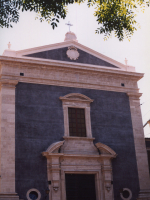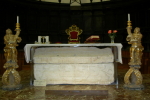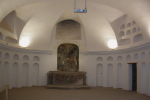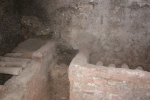
Going up via Garofalo and turn left into via Santa Maddalena, where, as a background of a small square, we find one of the oldest churches: S. Agata la Vetere.
After the edict of Constantine (313 d. C.) by San Severino bishop of the first years of peace, was built the church, begun in 380 and completed in 436 that was to replace the modest shrine built, almost secretly, on the ruins of the praetorian palace by the holy bishop Everio in 264.
.

The bishop established his chair and moved there the relics and the tomb that contained them possibly after 436 d. C. It was the custom of the first Christians to bury the martyrs quickly near the places of martyrdom, if they were outside the walls, to avoid desecration.
Here, in the apse, there is an ancient sarcophagus of white marble where, according to tradition, the body of the young martyr was buried (the church, moreover, is located south of an area used as a cemetery from the Hellenistic age to the Christian era).

The ancient sarcophagus, of pagan age and of fine workmanship, was chiseled in the parts portraying scenes not compatible with the Christian faith, like those of the "Hunting of the wild boar Calidonius" and the "Centauromachia".
On the side facing the visitor is clearly visible the pagan representation of two side griffins (symbol of strength and courage) with a candlestick in the center (the soul burning), left as symbols of virtue attributable to the saint

Interesting are the underground environments where there is a crypt where many loculi are dug along the walls and in the center there is an ancient altar with a well preserved fresco that depicts the spiritual benefits of the Eucharistic sacrifice for the souls of the deceased.